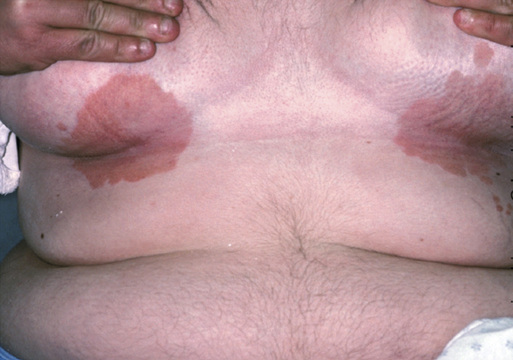JoAnn D. Lepke Intertrigo is a superficial inflammatory skin disorder that occurs in the setting of persistent skin-to-skin contact, friction, moisture, warmth, and inadequate ventilation. It is usually characterized by varying degrees of erythema, peripheral scaling, and macerated erythematous plaques. Common intertriginous sites include inframammary and abdominal folds, inner thighs, and axillary, interdigital, and perianal areas. Sweat retention, incontinence, immobility, alterations in systemic immunity, systemic antibiotic therapy, and overgrowth of resident microorganisms are related factors. If intertrigo is not treated, affected areas with impaired skin integrity can become secondarily infected with Candida (most common), Staphylococcus aureus, Pseudomonas aeruginosa, group A β-hemolytic streptococci, or Corynebacterium minutissimum.1,2 Patients are susceptible to intertrigo at any age, but it is more common in the young and in older adults. Women with vulvovaginitis, men with balanitis, individuals infected with human immunodeficiency virus (HIV), and prolonged steroid users are particularly susceptible.1 Other predisposing conditions and factors include diaper use, psoriasis, eczema, diabetes, obesity, pregnancy, oral contraceptive use, chemotherapy, and living in hot and humid climates.2 Obesity is associated with larger skinfolds with thick layers of subcutaneous brown fat, increasing the risk of overheating, friction, and moisture.1 Intertrigo is a skin disorder resulting in altered barrier function, which allows opportunistic infections such as yeast, bacteria, or fungi to infiltrate the skin. Moisture and friction are present, causing maceration in the stratum corneum, leading to erosion and skin breakdown and thus creating an opportunity for primary and secondary infections.3 Skin in elders and in diabetic and obese individuals has a higher skin surface pH than in other individuals.3,4 The skin’s barrier function may be more easily compromised in this situation, making it more vulnerable to organisms such as yeasts, bacteria, and other pathogens.1,3,4 Intertrigo is initially seen as mildly erythematous, moist, glistening plaques, patches, papules, and/or pustules. The borders are well defined, with areas of epidermal erosion and scaling. See Figure 58-1 for an example of inframammary intertrigo without fungal or bacterial infection. Pinpoint pustules outside the border are diagnostically important in candidal infections.3 Initial symptoms usually include itching, burning, and stinging.1–3 Odor, copious discharge, severe erythema, acute discomfort, fever, and abscesses may signal secondary infection.1,2 Diagnosis is typically based on clinical appearance. Scrapings from the lesion may be examined via potassium hydroxide (KOH) wet mount and/or Gram stain.5 A KOH preparation that is positive for pseudohyphae and budding spores confirms the diagnosis of Candida infection. Bacterial or fungal superinfection (e.g., Staphylococcus, group A β-hemolytic streptococci, P. aeruginosa, Proteus mirabilis) may be identified by culture. Examination with a Wood lamp may indicate erythrasma (coral-red fluorescence) or Pseudomonas infection (yellow-green fluorescence).1,3
Intertrigo
Definition and Epidemiology
Pathophysiology
Clinical Presentation and Physical Examination
Diagnostics
Intertrigo
Chapter 58








